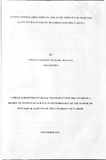| dc.description.abstract | One of the immediate challenges that Africa is facing in the fight against malaria is spread of the
parasite's drug resistance. As a result of this trend, Kenya among other endemic sub-Saharan
countries would have to turn to other more expensive drugs, for example artemisinin or
combinations of drugs. There is therefore an urgent need to step up research effort to develop
effective drugs that are affordable to low income population. The objective of this study was to
determine in vivo antimalarial effect on P. berghei- infected mice and their acute toxicity using
Brine shrimp lethality test, of five selected aqueous plant extracts, Azadirachta indica (L), Burm
(Meliaceae) root bark extract, voucher specimen number IN08; Dichrostachys cinerea,(L)
Wight et Arn (Mimosaceae), root extract, IN16; Grewia trichocarpa Hochst ex A. Rich
(Tiliaceae), root extract, IN022; Tamarindus indica L., (Caesalpiniaceae), stem bark extract,
JN038; and Acacia seyal (Del), (Mimosaceae), root extract, INOl. These plants were collected in
August 2009 from Msambweni district, Kenya based on their traditional reputation for their use
as antimalarials by Msambweni community. To evaluate antimalarial effect, each plant extract
was administered into chloroquinee (CQ) sensitive Plasmodium berghei-infected Swizz mice,
after which percentage chemosuppression was determined after four days of infection. To
evaluate acute toxicity of aqueous plant extracts, Brine shrimp lethality test was used where
Artemia salina nauplii were inoculated into 3.3% solution of artificial sea water at varying
concentrations of test extracts and percentage death determined after 24 hours. The lethal
concentration fifty (LCso), at 95% confidence interval and slope were determined from the 24
hour counts using the Finney computer programme. The five screened plant extracts suppressed
parasitaemia in the following increasing order: A. indica, 3.1%; D. cinerea, 6.3%; T indica,
25.1%; A. seyal, 27.8% and G. trichocarpa, 35.8% while chloroquine (positive control) had a
chemosuppression of 100%. One (20%) of the plant extracts had an LCsoof285.8~g/ml, and was
considered moderately cytotoxic. Two (40%) of the plant extracts had an LCso of 516.4 and
545.8 ug/rnl and were considered to be weakly cytotoxic while two (40%) of the crude plant
extracts had acute toxicity of 1000 ug/ml and above and were therefore non-toxic. The results
indicate that the aqueous extract of tested plant extracts when used alone as monotherapy, had a
non-significant (P ~ 0.05) antimalarial activity compared to that of chloroquine (100%). The
results also suggest that the anecdotal efficacy reported by the study community is related to
synergism of phytoconstituents since the assayed plant parts are used in combination with others
totreat malaria. It is also evident that none of the screened plant extracts is toxic to the arthropod
invertebrate, Artemia salina L. (Artemiidae) larvae, justifying the continued use of the plant parts
totreat malaria. Future work is suggested to evaluate the antimalarial activity of organic extracts
ofthe studied plant parts. | en |

